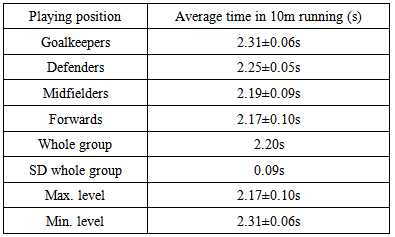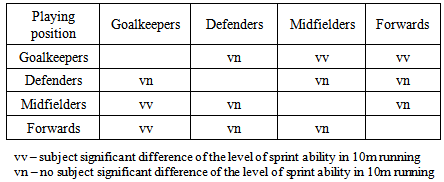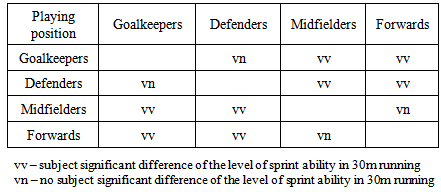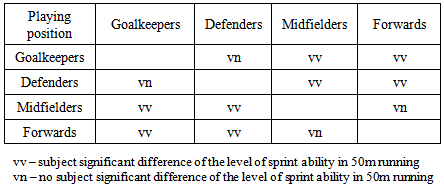-
Paper Information
- Previous Paper
- Paper Submission
-
Journal Information
- About This Journal
- Editorial Board
- Current Issue
- Archive
- Author Guidelines
- Contact Us
International Journal of Sports Science
p-ISSN: 2169-8759 e-ISSN: 2169-8791
2014; 4(6A): 65-70
doi:10.5923/s.sports.201401.09
A Level of Sprint Ability of Elite Young Football Players at Different Positions
Pavol Pivovarniček1, Martin Pupiš1, Roman Švantner2, Boris Kitka2
1Department of Physical Education and Sports, Matej Bel University, Banská Bystrica, The Slovak Republic
2Slovak Football Association, Bratislava, The Slovak Republic
Correspondence to: Pavol Pivovarniček, Department of Physical Education and Sports, Matej Bel University, Banská Bystrica, The Slovak Republic.
| Email: |  |
Copyright © 2014 Scientific & Academic Publishing. All Rights Reserved.
This The aim of the study was to analyse and compare the actual level of sprint ability in 10m, 30m and 50m from the point of view of playing positions of Slovak national under-21 football players U21 (N = 20, goalkeepers = 2, defenders = 4, midfielders = 8, forwards = 6) in time of qualification for European Under-21 Football Championship 2011. The level of sprint ability was measured with the device Fitro Light Gates (FiTRONIC, Bratislava, the Slovak Republic). The criterion of evaluation of the performance level was achieved time in distance of 10m, 30m and 50m from start from rest with accuracy 0.01s. Distance 10m, 30m and 50m was measured within one run. Differences in the level of sprint ability were determinated with special subject analysis. The level of sprint ability of the whole group in distance 10m was presented by average running time with the value 2.20±0.09s, in distance 30m with the value 4.59±0.09s and in 50m with the value 6.80±0.13s. In all measured sections (10m, 30m, 50m) there was recorded the highest average level of sprint ability by forwards (10m = 2.17±0.10s; 30m = 4.53±0.19s; 50m = 6.73±0.28s), then by midfielders (10m = 2.19±0.09s; 30m = 4.56±0.10s; 50m = 6.75±0.12s), by defenders (10m = 2.25±0.05s; 30m = 4.67±0.07s; 50m = 6.90±0.07s) and by goalkeepers (10m = 2.31±0.06s; 30m = 4.72±0.04s; 50m = 7.00±0.15s). The special subject analysis showed significantly better running time in the distance 10m by forwards and midfielders compared to goalkeepers. Significant differences were not noticed by defenders and other groups. In distance 30m and 50m was determined significantly better time by forwards and midfielders compared to defenders and goalkeepers. In distance 30m and 50m there were not noticed significant differences in time by defenders and goalkeepers. Significant differences were not noticed by forwards and midfielders too.
Keywords: Goalkeepers, Running time, Defenders, Midfielders, Forwards
Cite this paper: Pavol Pivovarniček, Martin Pupiš, Roman Švantner, Boris Kitka, A Level of Sprint Ability of Elite Young Football Players at Different Positions, International Journal of Sports Science, Vol. 4 No. 6A, 2014, pp. 65-70. doi: 10.5923/s.sports.201401.09.
Article Outline
1. Introduction
- The present professional football is characterised mainly by dynamics and constant increase in playing speed. The author [18] states that the biggest changes in football in last years were especially made in condition figures which regard to speed-force assumptions in playing performance. The condition according to [2] presents 30-40% of playing performance. We agree with the statement of [20, 18, 17], who say that football is intermittent movement activity which contains very short, usually 1 to 5 seconds continuing intervals of endurance with high to maximum intensity, which alternate with intervals of endurance with lower intensity or inaction continuing from 5 to 10 seconds. [1] founded out that football players who played in the competition UEFA Europa League in the seasons 2008/2009 and 2010/2011, 90% of their sprints lasted to 5 seconds. [12] declares that in the football match we can observe by player around 100 to 150 sprints with different length. The authors [8] show at the example of professional players that the performance in direct sprint is the most important component in offensive phase of scoring a goal. The most sprints in this activity occur without a competitor and a ball. According to these reasons the authors consider testing of sprint ability without change of direction as important part of physical readiness of a player. [14] writes that average time for ball control by the player in a match is 1.3 – 3.1 minutes. [18] declare 1 – 3 minutes. This implies that player moves without a ball next 87 minutes in the match. The most important parts are activities made at high intensity (running at speed more than 15km.h-1) from the point of view of the player in the match. [15] include the running acceleration, maximal sprint ability and agility, which exist usually in the match, into movement activities at high intensity. It concerns high variability of movements from the point of view of footballer´s movement technique. The football player is forced to use different types of running in the game (forward running, backward running) at different intensity, vertical jumps and drops, fast rebounds and getting up after drops, work with the ball and without the ball.According to [18] the active concept of offensive and defensive phase of the game in playing systems is applied more in present football. This concept is characterised by involvement of more players in both phases of the game. It means fast switch of groups of players in transition phases from defence to offense and vice versa, movement activity on the large area of the field, which is evident in spatial intersection of players from particular groups and horizontal and vertical circulation of players in offensive phase. [11] discovered that Norwegian national football players and players of the Norwegian highest league achieved higher performance from the point of view of the acceleration and running speed (P<.05) than players of 2nd division (difference 1.0-1.4%), 3rd – 5th division (difference 3.0-3.8%), junior national team (difference 1.7-2.2%) and junior players (difference 2.8-3.7%). Considering that this research lasted more years (1995-2010, n = 939, age = 22.1±4.3 years), the authors had the possibility to determine that players in years 2006-2010 were faster about 1-2% in 20m running in comparison with players in years 1995-1999 and 2000-2005. Given studies suggest the fact that in training process of football players are stimulations for development of sprint ability, which is the part of total performance of a football player, very necessary. We know that level and development of sprint ability is genetically determinated and it depends on neuromuscular coordination and representation of fast muscle fibres. The level of sprint ability is influenced by the right running technique too, which is dependent on quality and character of long-lasting training process and sport preparation.
2. Purpose of the Study
- In this study we focused on comparison of actual level of sprint ability from the point of view of playing positions in 10m, 30m and 50m running by Slovak national under-21 football players in time of qualification for European Under-21 Football Championship 2011.
3. Methodology
- The observational group consisted of Slovak national under-21 football players (n = 20, goalkeepers = 2, defenders = 4, midfielders = 8, forwards = 6), who fought for classification in the UEFA European Under-21 Football Championship 2011 in Denmark in the 7th qualification group together with U21 national teams from Croatia, Serbia, Norway and Cyprus. Measurements were realised on October 8th, 2009 in the morning, when we as well as [13] can speak about first daily peak of performance. Diagnostics of the level of sprint ability took place in Národné tréningové centrum (NTC) in Senec before qualification match with the national team of Cyprus for European Under-21 Football Championship on October 14th, 2009 in Achnas. Before diagnostics football players went through general warm-up (10 minutes) and speed warm-up (10 minutes).Sprint ability was measured with the device Fitro Light Gates (FiTRONIC, Bratislava, The Slovak Republic) in 10m, 30m and 50m running from the middle-standing start at the football field with natural grass. Measurement of sprint ability in 10m, 30m and 50m running was realised within one running. Measured football player posed a starting position on a start line at the beginning of measurement and started to run with the audio signal „Hop“ which was at the same time a tripper of measuring in the computer device. He ran with maximal effort 3 to 5m behind the photocell so that the maximum possible speed could be measured during the whole measured distance of 50m. Within one measurement the football players took two trials. We have chosen a better trial to the evaluation.In presented study we have used within descriptive statistics arithmetic average (x) from criteria for central tendency and standard deviation (SD) from criteria for variability.We determined the importance of differences in the level of sprint ability in 10m, 30m and 50m with special subject analysis. The criterion of subject significance was the value of 1 SD of the average level of sprint ability (10m, 30m, and 50m) from the whole group. When it came to difference in the evaluation of the level of sprint ability (10m, 30m, 50m) minimum about one value of SD including the value of SD between the groups of players according to their playing positions (goalkeepers, defenders, midfielders, forwards), so we considered it as subject significant difference. The criterion for evaluation of the performance was achieved time in the distance of 10m, 30m and 50m. In this study we evaluate the level of sprint ability in 10m, 30m and 50m running in time with the exactness of 0.01s.
4. Results
- The average level of sprint ability of the whole group of players in 10m running was 2.20±0.09 s. According to results we state the highest average level by forwards, then by midfielders, by defenders and the lowest average level of sprint ability was by goalkeepers (Table 1).
|
|
|
|
|
|
5. Discussion
- Diagnostics of movement abilities can be a decisive factor of the level of individual, especially limiting movement abilities, for coaches and realisation teams of football teams. On the other hand, neither the excellent level of movement abilities does not mean automatically transfer into individual player´s performance and into performance of the whole team. The insufficient level of movement abilities limits player´s performance, especially on the top level where details decide the matches. We agree with statements of [21] that football players do not have to dispose with extraordinary performance in any field of physical performance but they have to have appropriate high level in all fields. The authors [3] mention that physiological presuppositions and norms represent necessary conditions for success at the professional level, but they are not sufficient.In football the sprint ability, especially with acceleration character for short distances, belongs to limiting movement presuppositions in achievement of the top performance on the world level. The sprint ability is joined especially with reaction speed in game conditions. In our study we have used tests of sprint ability from middle-standing start on audible signal. We have included reaction speed intentionally together with start on audible signal, so it made the difference in final level of sprint ability of tested football players. On the other hand it is necessary to notice that the majority of impulses in the game have a visual character.The problem of level comparison of speed abilities of football players from the point of view of playing positions can be a helpful indicator by watching and interpretation of success in various playing situations, for example the micro-situation forward – defender. We agree with authors [7] that acceleration is important factor of success in team sports. High level of speed abilities, especially with acceleration character creates higher presupposition of catching the ball earlier than the competitor and have the playing situation and game development under control.From the point of view of comparison of movement performance by individual playing positions, forwards have achieved the best time in all monitored running parameters. This result corresponds with finding of authors [22] who present that the best results achieve forwards. The reason can be their adaptability to offensive impulsive activities for short and long distance (ex. place choice, pressing, re-pressing) during the match with consequent adequate recovery by returning to defence position, focusing and content of training process and possible selection of fast types of players. In 10m running we have not noticed significant differences by the players at the field when we compared the groups according to playing positions. Only goalkeepers have achieved significantly lower level of sprint ability in comparison with other playing positions. There are situations in goalkeeper ´s game where it is necessary to run a certain distance and accelerating speed is limiting factor for successful solution of playing situation. It will be necessary to focus on this parameter in training process. In 30m and 50m running we have determined significantly lower level of sprint ability not only by goalkeepers but also by defenders in comparison with forwards and midfielders. This finding can be the consequence of the fact that in our study we had only four central defenders and two of them alternate on the positions of wing defenders. According to demands of present football there exist noticeable differences between wing and central defenders. Especially it means fast switches of wing defenders on vertical lines with the view of backup of attacking phase of the game and consecutive returns to defence phase. The reason for discovered significant lower level of sprint ability in 30m and 50m running can be lower adaptability in sprints for longer distances by our defenders. In our study we have tested young footballers with possibility of changing their playing position in the future, so we did not differentiate central and alternated central or wing defenders in the analysis of running parameters. [19] did not discover significant differences in 30m running among the groups of defenders, midfielders, forwards and goalkeepers at professional or amateur level (n = 78, age = 21.0±4.9 years). [24] did not discover significant differences among football players of Turkish leagues in 30m sprint according to playing positions too (n = 243, age = 24.3±3.5 years). As well as [10] did not determine significant differences among playing positions according to speed abilities. The average level of sprint ability of our players in 10m running was indicated with time 2.20±0.09s. [16] discovered that Czech national U16 football players (N = 23) achieved the level of sprint abilities in time 1.87±0.10s in 10m running on the surface with artificial grass. [5] found out that French first league players (n = 29) achieved the average level of sprint abilities in time 1.80±0.06s in 10m running on the surface with natural grass. [6] discovered that first league players (n = 20, age = 23.5±3.7 years) from French team FC Nantes reached the average performance in 10m running with the value 1.82±0.08s on the surface with natural grass too. [23] determined that players from English team in Premier League (n = 19, age = 22.0±2.0 years) achieved the average performance in time 1.75±0.08s. [25] discovered that players from Norwegian elite team Rosenborg FC Trondheim (n = 17, age = 25.8±2.9 years) achieved the level of sprint abilities with the value 1.82±0.30s. Measurement was made in indoor shoes on the wooden floor. Determined time of players from our team is influenced by the fact that players started on audible signal. The final performance in our test was influenced by reaction speed and it influenced the results in 30m and 50m running too. The average level of sprint ability of players in 30m running was indicated with time 4.59±0.09s. [5] found out that French first league players (n = 29) achieved the average level of sprint abilities in time 4.22±0.19s in 30m running on the surface with natural grass. [25] discovered that players from Norwegian elite team Rosenborg FC Trondheim (n = 17, age = 25.8±2.9 years) achieved the level of sprint abilities in 30m running with the value 4.00±0.20s. Measurement was made in indoor shoes on the wooden floor. [23] determined that players from English team in Premier League (n = 19, age = 22.0±2.0 years) achieved the average performance in time 4.28±0.12s. [4] state that Tunisian national U19 football players and Senegal elite junior players (n = 34, age = 17.5±1.1 years) achieved the level of sprint ability on the natural grass with time 4.38±0.18s. [9] state that Czech first league back-up players (n = 14, age = 20.2 years) achieved the average performance indicated with time 4.36s (4.05–4.60). It is necessary to mention the limits of carried research too. The subject matter of this study was direct sprint ability in 10m, 30m and 50m running. In is important to mention that performance in direct sprint is specific precondition only because playing performance of a footballer is influenced by variability of playing conditions and actual game demands. The specific movement ability becomes evident with changes of frequency, changes in length of step and also changes in running direction because the player is forced to regulate constantly his direct movement on the ground of perception of external conditions. It is cooperation with teammates for example, perception of opponents and realising of running sprint with a ball. As well as by realizing of shooting the player is forced to adjust the sprint technique before shooting. All these reasons can be necessary for creating of specific field test in the future which will be valid for sprint ability and will compare with the tests we present in this study. The unrepeated testing is certain limitation too and it is joined with limitation in reliability. The unrepeated measurement can be influenced by external conditions but also by actual internal disposals of examined individual. Other limitation was the fact that achieved results were not interpreted in the relationship to the morphology of players and it would be necessary to examine running technique too.The study can be an inspiration for condition and athletic coaches of football teams in order to reveal and eliminate weak aspects of their young players, especially in condition trainings in preparatory seasons and individual trainings according to actual results of diagnostics during entire annual training cycle. Given data can serve as certain norm or standard for elite young football players from the point of view of the level of sprint ability.
6. Conclusions
- The results of special subject analysis have showed differences in the level of sprint ability among groups of football players in the Slovak national under-21 football team according to playing positions. The highest level of sprint ability achieved forwards in all measured distances, then midfielders and defenders. The lowest level of sprint ability had goalkeepers.From the point of view of sprint ability in 10m running we have discovered that significantly higher level of sprint ability was noticed by midfielders and forwards in comparison with goalkeepers. The significantly different level was not noticed among defenders and other groups.The analysis of sprint ability has showed that there was significantly higher level by forwards and midfielders in 30m and 50m running in comparison with defenders and goalkeepers. There were not discovered significant differences among the level of sprint ability of defenders and goalkeepers in 30m running, as well as among the level of forwards and midfielders.
 Abstract
Abstract Reference
Reference Full-Text PDF
Full-Text PDF Full-text HTML
Full-text HTML




